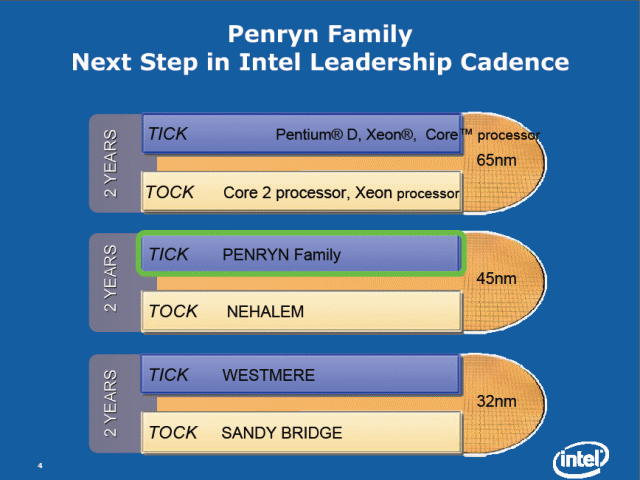For Day 13 of this series, I want to talk some more about the Intel Tick-Tock Development model and why it is important for the database professional. For the last seven to eight years, Intel has implemented a pretty consistent and predictable processor development and release cycle. A Tock release is a completely new microarchitecture that uses the existing manufacturing process technology. A Tick release takes the existing microarchitecture and moves to a smaller manufacturing process technology, sometimes with some added architectural improvements. Tock releases happen every two years, while the Tick release happens the following year, which means you get a Tick or a Tock release pretty much every year. In a nutshell, the Tick-Tock development model helps you plan for when it makes the most sense to make a platform upgrade, by looking at what Intel is doing with processor releases and seeing how that relates to what Microsoft is doing with operating system and SQL Server releases.
As you think about this, you also have to keep in mind that there are some important differences in the release cadence based on the different market segments that Intel serves. Tock releases show up first for the high-end mobile and desktop market, and then for the entry-level server and workstation market about two-three months later. After a delay of another three-twelve months, you will see a new Tock release show up in the two-socket server market, and then sometime later (anywhere from three to eighteen months), you will see that same Tock release show up for the four-socket and larger market. These time-frames will also vary based on how much competitive pressure Intel is getting from AMD (which is not very much over the past several years). Intel sometimes skips releases for the four-socket market. For example, there was no Sandy Bridge-EX.
We are supposed to see the initial Haswell mobile and desktop release on June 2, 2013, with the initial Haswell Xeon E3-1200 v3 processors becoming available at about the same time. The two-socket Xeon E5-2600 v2 Ivy Bridge-EP is supposed to be released in Q3 of 2013, while the four-socket and larger Xeon E7-4800 v2 is supposed to be released in Q4 of 2013.
Table 1 shows a “family tree” for Intel processors from 2006 to 2016. The Tock releases are the darker bands in the table.
Table 1: Intel Server Processor Family Tree
I did a little searching for different Tick-Tock images, from oldest to newest, so that you could see the history of this development model over a longer period of time.
Figure 1: 65nm Xeon 5000 Through Sandy Bridge
Figure 2: 65nm Xeon 5100 (Merom/Woodcrest) Through Sandy Bridge

Figure 3: 45nm Xeon 5400 (Penryn/Wolfdale) Through Ivy Bridge
Figure 4: 45nm Xeon 5500 (Nehalem) Through Haswell
Figure 5: 32nm Xeon 5600 (Westmere) Through Skylake

Figure 6: Process Technology Roadmap
If you would like some more low-level detail about these trends, you should take a look at this presentation that Mark Bohr gave for IDF2012.



